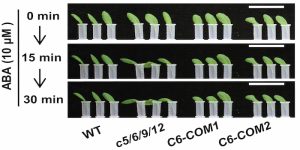Abscisic acid–activated calcium channels limit transpirational water loss
Yan-Qiu Tan, Yang Yang, Meijun Zhu, and Yong-Fei Wang
National Key Laboratory of Plant Molecular Genetics, CAS Center for Excellence in Molecular Plant Sciences, Chinese Academy of Sciences; University of Chinese Academy of Sciences, Shanghai 200032, China
Background: Plants ‘breathe’ through stomata, tiny pores on the leaf surface that are surrounded by guard cells; changes in guard cell volume close or open the stomata. To prevent water loss through these pores, plants under drought stress induce the biosynthesis and mobilization of the phytohormone abscisic acid (ABA). ABA induces the stomata to close by triggering cytosolic Ca2+ increases/oscillations in guard cells. Cytosolic Ca2+ increases/oscillations transduce signals in all eukaryotes and it has been postulated for years that the plasma membrane Ca2+ channels of guard cells, the cyclic nucleotide-gated channels (CNGCs) are the core players responsible for generating and regulating ABA-specific cytosolic Ca2+ oscillations. However, the ABA-activated Ca2+ channels have remained unknown.
Question: We aimed to identify the ABA-activated Ca2+ channels in Arabidopsis guard cells.
 Findings: We constructed transgenic Arabidopsis lines carrying dominant negative versions of specific CNGCs and a quadruple mutant that lacks the function of four CNGCs (c5/6/9/12). The dominant negative and loss-of-function lines show a dramatic reduction in ABA-triggered Ca2+ influx and disrupted ABA-specific cytosolic Ca2+ oscillations. In these lines, stomatal closure and transpirational water loss were also insensitive to ABA, compared with wild type. Expressing a single one of the four CNGCs (under its native promoter) rescued these phenotypes in the c5/6/9/12 quadruple mutant. Thus, we identified a type of ABA-activated Ca2+ channels required for stomatal closure in Arabidopsis.
Findings: We constructed transgenic Arabidopsis lines carrying dominant negative versions of specific CNGCs and a quadruple mutant that lacks the function of four CNGCs (c5/6/9/12). The dominant negative and loss-of-function lines show a dramatic reduction in ABA-triggered Ca2+ influx and disrupted ABA-specific cytosolic Ca2+ oscillations. In these lines, stomatal closure and transpirational water loss were also insensitive to ABA, compared with wild type. Expressing a single one of the four CNGCs (under its native promoter) rescued these phenotypes in the c5/6/9/12 quadruple mutant. Thus, we identified a type of ABA-activated Ca2+ channels required for stomatal closure in Arabidopsis.
Next steps: We plan to explore the underlying molecular mechanisms of how the CNGC channels are integrated into the signaling network for ABA-induced stomatal closure. Our findings also open the door to many studies that will expand our understanding of Ca2+ signaling in ABA-induced stomatal closure and other ABA-related processes.
Reference:
Yan-Qiu Tan, Yang Yang, Xin Shen, Meijun Zhu, Jianlin Shen, Wei Zhang, Honghong Hu, and Yong-Fei Wang (2022) Multiple cyclic nucleotide-gated channels function as ABA-activated Ca2+ channels required for ABA-induced stomatal closure in Arabidopsis. https://doi.org/10.1093/plcell/koac274



